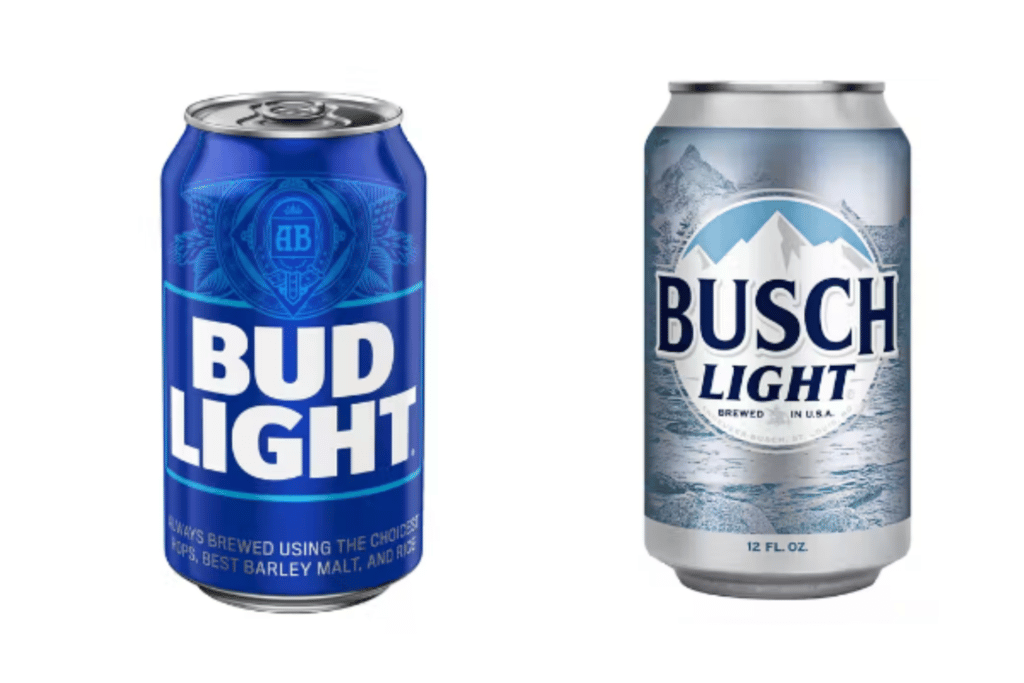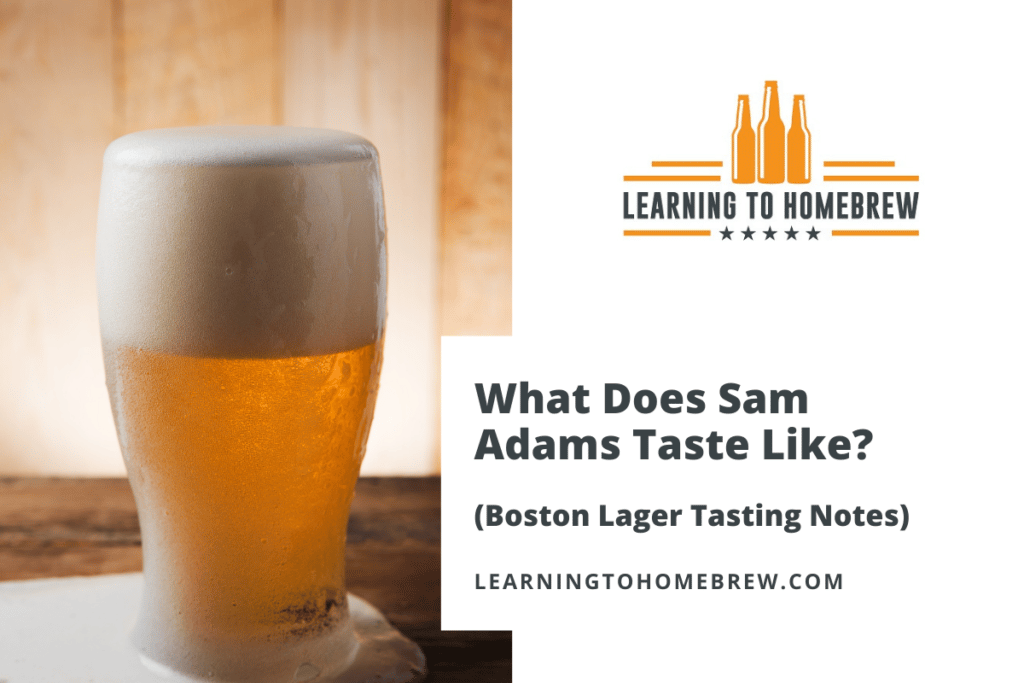If it came down to Bud Light vs Busch Light, would you be able to explain why you’d pick one over the other? What are the differences between these two American light beers?
Bud Light and Busch Light are both light beers with a relatively low ABV – just over 4%. Because of differences in the yeast used, Bud Light is a light ale while Busch Light is a light lager. Busch Light has fewer calories and about half the carbs. Despite the health stats and slightly lower price, Busch Light can’t equal Bud Light in popularity.
Although they are different styles, you might be surprised by what these two cold ones have in common – and what they don’t. Keep reading to find out more about both beers!
Topics We Cover
Busch Light vs Bud Light comparison overview
Brewed by Anheuser-Busch, Bud Light is a popular light beer that has been around since 1982. Anheuser-Busch also makes several other styles of Bud Light as well as Budweiser and several other beers.
Bud Light is low in calories and cheap with a simple recipe. Though it is often dismissed as a bad beer, it can be crisp and refreshing. With its lower ABV, it is easily sessionable.

Also brewed by Anheuser-Busch, Busch Light has been around since 1989. It was originally called Busch Light Draft until 1994 when it became simply Busch Light.
Busch Light is a light lager which means it is brewed at a lower temperature than an ale such as Bud Light. Like many mass-market lagers, Busch Light is brewed with barley and additional grains – in this case, corn is likely.
Released slightly after most light beers, Busch Light was another attempt to break into the light beer market. It is another cheap light beer comparable to Natural Light.
| Comparison | Bud Light | Busch Light |
|---|---|---|
| Calories | 110 | 95 |
| Carbs | 6.6 grams | 3.2 grams |
| ABV | 4.2% | 4.1% |
| Ingredients | Barley, rice, water, yeast, hops | Water, barley, rice, hops, yeast |
| Taste | Crisp, light maltiness, carbonation | Light maltiness, a hint of lemon |
| Aroma | Light maltiness | Light maltiness |
| Cost | $10 | $8.50 |
| Popularity (in popular opinion Q3 2022 US) | 12th | 24th |
| History | First released in 1982 as Budweiser Light | First released in 1989 as Busch Light Draft |
What is the difference between Bud Light and Busch Light?
When it comes to these two beers there are many factors we can use to compare them. Let’s break down the differences between Bud Light and Busch Light using several basic criteria.
The main differences between Bud Light and Busch Light are:
- Bud Light vs Busch Light calories
- Bud Light vs Busch Light carbs
- Bud Light vs Busch Light alcohol content (ABV0
- Bud Light vs Busch Light ingredients
- Bud Light vs Busch Light taste, flavors, and aroma
- Cost
- Popularity and sales
- History
The first few characteristics – calories, carbs, alcohol content, and ingredients – help to determine the objective differences between the recipe and the final product.
Then we can break down why people like one over the other. By covering the taste, flavors, and aromas of the two beers we can highlight some of the subjective reasons for people’s preferences.
Lastly, we’ll cover the marketing and history of the two beers. That will include the cost, popularity, and sales of Bud Light and Busch Light.
Bud Light
Bud Light is one of the most popular beers in the United States – at least as far as sheer quantities purchased go.

Bud Light was introduced in the 80’s and has remained popular because of its relatively low cost, near-ubiquitous availability, and easy drinkability.
Bud Light doesn’t win any awards when it comes to craft beer drinkers, but it’s a stalwart favorite of just about anyone whose favorite kind of beer is “cold.”
Calories, carbs, and other nutritional facts
While not as good for you as initial marketing may have led you to believe, light beers are lower in carbs and calories than the mainstream beers that came before.
A 12-ounce can of Bud Light contains 110 calories, 6.6 grams of carbs, 0.9 grams of protein, and 0 grams of fat.
Of course, that’s not a huge improvement over big brother Budweiser’s 145 calories, but it does improve significantly on its 22 grams of carbohydrates. If you’re counting macros, you may want to check out Bud Light Next, a light beer with 0 carbs.
Alcohol Content (ABV)
Sometimes it seems like craft beers are in a race to the highest ABV, but the mass-market approach is practically the opposite.
Each 12-ounce can or bottle of Bud Light has 4.2% alcohol by volume (ABV).
Between the light, refreshing taste and the low ABV, Bud Light’s popularity can be attributed almost entirely to the sheer number you can pound back while you’re out on the lake.
Ingredients
The exact recipe is an industry secret, but we know the main ingredients for this popular brew.
Bud Light is brewed with just 4 ingredients: water, barley, hops, and rice. Yeast is also used in brewing, but the exact strain has not been revealed.
The type of hops, strain of yeast, style of malt, or other specifics of the recipe aren’t released to the public but have a large impact on the end result.
Taste, flavors, and aroma
Bud Light is easily one of the most consumed beers in the world, but it’s hard to imagine a cicerone (aka a beer sommelier) listing out the notes and complex flavors after sniffing a fresh draft.
Bud Light tastes of mild breadiness and other malty flavors. There is some light sweetness to accompany the malt flavors. It has a quite carbonated but watery mouthfeel. The aroma is similar to the taste. A light breadiness with a hint of hops.
The beer is overall crisp and light. If you drink it in a can you will get a bit of the metallic quality.
Cost
In the case of mass-market beers, affordability rides right alongside drinkability.
A 6-pack of Bud Light costs roughly 10 dollars. The price will be roughly higher or lower depending on your area. Individual tall cans (25 oz.) cost approximately $2.75.
Bud Light is available in many different quantities. There are 6-packs, 12-packs, 30 racks, and more.
Popularity and sales
It may never be the prettiest girl at the party, but Bud Light’s definitely going home with someone.
According to YouGovAmerica, Bud Light is the 12th most popular beer in the US. In 2020, Anheuser-Busch shipped 26.5 million barrels of Bud Light.
This was a 6.5% decrease from the previous year.
History
Budweiser had already been making beer for more than 100 years when it introduced Bud Light as a lighter, more refreshing option.
In 1982 Bud Light was first sold as Budweiser Light. In 1984 it was rebranded Bud Light.
Bud Light and Miller Lite have been feuding since 1985 via marketing, other beers by the two breweries, and legal battles.
Busch Light
Busch Light is also produced by Anheuser-Busch, the maker of Bud Light. While they are made by the same company and are both light beers, they are very different in terms of style, taste, and market appeal.

Busch Light Draft was introduced in 1989; it became the Busch Light we know today in 1994. This light lager tastes of malt with minimal flavor. A 12-ounce serving has 95 calories and just 3.2 grams of carbs. You can pick up a 6-pack for about $7.
Busch Light is available in cans, bottles, and on draft and many bars and restaurants.
Calories, carbs, and other nutrition facts
Busch Light has fewer calories and about half the carbs of Bud Light.
A 12-ounce can of Busch Light contains 95 calories, 3.2 grams of carbs, 0.7 grams of protein, and 0 grams of fat.
Alcohol Content (ABV)
Most light beers have a relatively low ABV, and Busch Light comes in at the lower end of even those.
Each 12-ounce can of Busch Light has 4.1% alcohol by volume (ABV).
This is one of the few light beers that is not 4.2% ABV.
Ingredients
As with most corporate recipes, the details of brewing Busch Light are a tightly guarded secret.
Busch Light is brewed with water, barley, rice, hops, and yeast. The rice is responsible for its crisp taste and mouthfeel.
The exact quantities and specific ingredients are not revealed to the public.
Taste, flavors, and aroma
Busch Light is a dry beer with a crisp mouthfeel.
Busch Light is light in flavor with some notes of malt and a hint of lemon. The aroma is similar to bready notes. There is decent carbonation to go with the watery mouthfeel.
The beer is best enjoyed cold which mutes the flavors but enhances the refreshment.
Cost
Most light beers are pretty affordable and a night’s worth of Busch Light isn’t likely to break the bank.
A 6-pack of 12-ounce Busch Lights costs roughly $8.50 depending on location. Whether you buy cans or bottles will also affect the price.
Other packaging options include 30 packs.
Popularity and sales
Busch Light is nowhere near as popular as Bud Light, but it still made it into the list of the 10 most popular beers in the U.S. for 2019.
Busch Light is a popular beer that draws in consumers due to its outdoor branding and refreshing taste.
In 2019, Busch Light shipped 6.3 million barrels. This was a 1.6% increase over 2018.
History
Busch Light is produced by Anheuser-Busch and is the light version of Busch Beer.
Introduced in 1989, Busch Light was first called Busch Light Draft. This was changed in 1994 when they dropped “draft” from the name. In 2006, Busch Light began to be sold in camouflage cans.
Since then, Busch put a bullseye on its target market and has released several limited edition can designs to both appeal to its demographic and be in on the joke with them.





